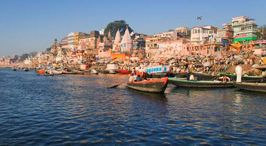
- Mobile
+91-9958308506
- E-Brochure
Download E-Brochure


Varanasi is also Benares, Banaras Kashi is a city on the banks of the Ganges (Ganga) in Uttar Pradesh, 320 kilometres (200 mi) southeast of the state capital, Lucknow. It is holiest of the seven sacred cities (Sapta Puri) in Hinduism and Jainism. Hindus believe that death at Varanasi brings salvation. It is one of the oldest continuously inhabited cities in the world and the oldest in India.Many of its temples were plundered and destroyed by Mohammad Ghauri in the 12th century. The temples and religious institutions in the city now are dated to the 18th century.
The Kashi Naresh (Maharaja of Kashi) is the chief cultural patron of Varanasi, and an essential part of all religious celebrations. The culture of Varanasi is closely associated with the Ganges. The city has been a cultural center of North India for several thousand years, and has a history that is older than most of the major world religions. The Benares Gharana form of Hindustani classical music was developed in Varanasi, and many prominent Indian philosophers, poets, writers, and musicians live or have lived in Varanasi. Gautama Buddha gave his first sermon at Sarnath located near Varanasi.
Varanasi is the spiritual capital of India. Scholarly books have been written in the city, including the Ramcharitmanas of Tulsidas. Today there is a temple of his namesake in the city, the Tulsi Manas Mandir. One of the largest residential universities of Asia the Banaras Hindu University is located here. Varanasi is often referred to as "the city of temples", "the holy city of India", "the religious capital of India", "the city of lights", "the city of learning", and "the oldest living city on earth."
The name Vārāņasi possibly originates from the names of the two rivers: Varuna, still flowing in Varanasi, and Asi, a small stream near Assi Ghat. The old city does lie on the north shores of Ganges River bounded by its two tributaries Varuna and Asi. Another speculation is that the city derives its name from the river Varuna, which was called Varanasi in olden times. This is generally disregarded by historians. Through the ages, Varanasi has been known by many names including Kāśī or Kashi (used by pilgrims dating from Buddha's days), Kāśikā (the shining one), Avimukta ("never forsaken" by Shiva), Ānandavana (the forest of bliss), and Rudravāsa (the place where Rudra/Śiva resides).
In the Rigveda, the city is referred to as Kāśī or Kashi, the luminous city as an eminent seat of learning. The name Kāśī is also mentioned in the Skanda Purana. In one verse, Shiva says, "The three worlds form one city of mine, and Kāśī is my royal palace therein."
According to legend, Varanasi was founded by the god Shiva. The Pandavas, the heroes of the Hindu epic Mahabharata are also stated to have visited the city in search of Shiva to atone for their sins of fratricide and Brāhmanahatya that they had committed during the climactic Kurukshetra war. It is regarded as one of seven holy cities which can provide Moksha:
Ayodhyā, 2 Mathurā, 3 Gayā, 4 Kaśī, 5 Kañchi, 6 Avantikā, 7 Dwārāvatī, 8--these seven cities should be known as the givers of liberation.
The earliest known archaeological evidence suggests that settlement around Varanasi in the Ganga valley (the seat of Aryan religion and philosophy) began in the 11th or 12th century BC, placing it among the world's oldest continually inhabited cities. These archaeological remains suggest that the Varanasi area was populated by Vedic people. However, the Atharvaveda (the oldest known text referencing the city), which dates to approximately the same period, suggests that the area was populated by indigenous tribes. It is possible that archaeological evidence of these previous inhabitants has yet to be discovered. Varanasi was also home to Parshva, the 23rd Jain Tirthankara and the earliest Tirthankara accepted as a historical figure in the 8th century BC.
Maharaja Express Guest Always Special for us
 Comparison Chart
Comparison Chart Fact Sheet
Fact Sheet  History
History